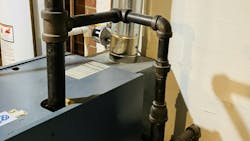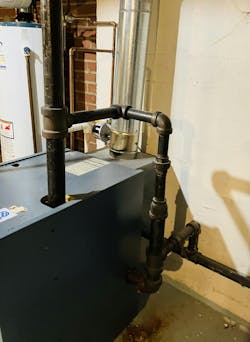If you’re one of the rare regular readers, you know by now that I like steam heat. If asked why, I would say it’s the uniqueness of the jobs I look at. I don’t think that they are ever the same, and I don’t like to speak in extremes. But I seem to always find something new, interesting, or different about each steam system.
A Trip to Utopia
This job was going to be interesting from the beginning. The contractor didn’t give me much information, just the address. It was in a town that was developed as a suburb of Cincinnati in the early 1920’s by a philanthropist. She had lots of money and wanted to create her own utopia where all the economic classes could live together.
The idea was to have a town laid out with a business center, surrounded by housing of all levels, from apartments to townhouses to small homes, etc. The part that always intrigued me was the district steam heating system that was part of the plan. I could never get a good answer on how much of the town it served.
Whenever I would go to the area to help a contractor with a steam boiler replacement, I would look at the piping for any indications that it was originally on the district steam heat. The homeowners would sometimes share their opinions or memories, but rarely did I find much evidence. The only thing for sure was that the district steam heat had been abandoned.
Big Plans - Small Space
Pulling up to this job, I noticed that it was a townhouse located near where I believed the original steam plant was located, which curiously was at the corner of the town, not near the center. The email invitation mentioned that I would be advising on the relocation of a radiator. Besides boiler replacements, this contractor works with remodeling contractors moving or replacing radiators for kitchen/bath remodels.
Walking into the place, it had the appearance of a gut job, lots of walls without plaster and floors you can see through. When the piping is exposed, it makes the system easier to understand. In this instance, the remodeling contractor was the nice couple that had bought the townhouse from a little old lady that had lived there for a long time.
They had big plans for the small space and were actually interested in converting the steam system to high efficiency hot water. Anytime that is mentioned, I state that I have to take a good look at the piping to identify what needs to be done. So off to the basement we went, where I could also look for the elusive district heat connection.
Following the Trail
It is a two-pipe steam system with radiators from the 1920’s that have the top and bottom connections on the radiator sections. That’s the first thing to check. Next thing is to find the end of the steam main(s). Even though it was a small townhouse, it had two end of steam mains. Each end of steam main had an awkwardly located steam trap. One had the steam vent in photo 1, awkwardly positioned at a 45-degree angle instead of straight up. Please don’t copy this technique.
The traps were the tip off that this townhouse was on the district steam heat, since they were out of character for an original installation, which wouldn’t have used traps. It wasn’t hard to find the original connection from the street to the townhouse’s steam distribution piping. It was however, capped off on the opposite side of the basement from where the existing boiler was sitting.
The steam from the boiler enters the existing piping and has to counter flow against the condensate coming back down the pipe. The existing pipe was sized for parallel flow, not counter flow, which usually requires a larger pipe size. The boiler supply should have been run to the connection for the district heat.
70 Years of Problems
It is not the boiler that would have been installed in the summer of 1954, when the city decided to shut down the district steam system, but one of many that used that same connection. I imagine that this system had its share of problems for the past 70 years.
I include this picture to see if you can spot the obvious mistakes with the near boiler piping. The equalizer is not connected to a horizontal header, but taken off the vertical supply line, which eventually turns horizontal to feed into the wrong spot as mentioned before. It can equalize pressure to the return side, but it can’t drain any condensate from the supply riser/header, minimizing the “drying” effect.
The other mistake is with the Hartford Loop. The horizontal distance looks to be about two 4” long nipples and a union in total length. Every boiler manufacturer’s installation instructions say that it should be as short as possible, usually recommending a close or shoulder nipple to lessen the chance of water hammer.
Termites and cheap natural gas were the cause of the district steam heat’s demise. The steam lines run underground from the steam plant to the buildings were insulated with wood, which the termites aggressively removed, leading to high transmission losses.
The coal-fired steam plant was built for much more capacity than was ever hooked up, so it was operating inefficiently with no new hook-ups since the 1930s. Ironically, the building was sold and converted to cold storage.
Patrick Linhardt is a forty-year veteran of the wholesale side of the hydronic industry who has been designing and troubleshooting steam and hot water heating systems, pumps and controls on an almost daily basis. An educator and author, he is currently Hydronic Manager at the Corken Steel Products Co.
About the Author
Patrick Linhardt
Patrick Linhardt is a forty-one-year veteran of the wholesale side of the hydronic industry who has been designing and troubleshooting steam and hot water heating systems, pumps and controls on an almost daily basis. An educator and author, he is currently Hydronic Manager at the Corken Steel Products Co.


